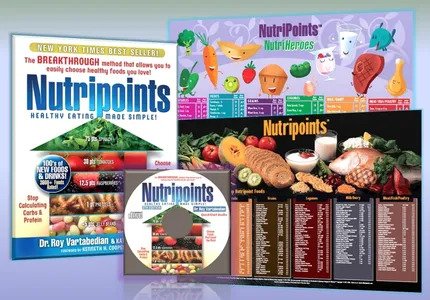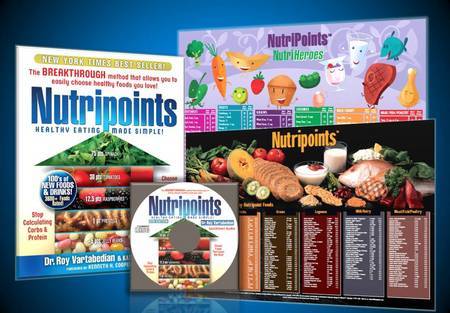Nutripoints News
Healthy Eating Made Simple!
You want to eat healthy, but your good intentions quickly fade as you begin–and immediately encounter having to account for quantities of cholesterol, fats (saturated, polyunsaturated, monounsaturated), sodium, vitamins, minerals, trace elements, and fiber (soluble and insoluble) in your daily diet. You begin to realize that it may be easier to balance the federal budget than to understand and balance your own diet!
It’s very clear which foods are really bad for us and which are really good–we seem to instinctively know those items. But it’s the gray area, the foods that have some good characteristics and some bad ones that make up most of our daily eating, and those are the ones that give us the most concern. For example, have you ever tried to figure your way out of these nutritional see-saws?
- a food high in calcium, but also high in fat (dairy products)
- a food low in fat, but high in sodium (crackers, soups)
- a food high in protein, but also high in fat (meats)
- a food low in cholesterol, but high in saturated fat (margarines, palm oil)
- a food low in calories, but also low in nutrients (iceberg lettuce, celery)
Until now there has been no way to simply compare one food to another in terms of it’s overall nutritional value. Solving this problem is Nutripoints, a revolutionary nutritional system that replaces counting calories, worrying over fats, sugar, and sodium, calculating cholesterol, and figuring out the U.S. Recommended Daily Allowances. It does all this and more with a point system which provides one number for each food that can help you maintain a healthy diet.
I developed the Nutripoint system through 10 years of research with people who had serious health problems like heart disease, diabetes, hypertension, hypercholesterolemia, and obesity. They needed a simpler way of juggling all of the variables of nutrition when they got back home after visiting our lifestyle change program at the Cooper Clinic Residential Wellness Program in Dallas.
Unlike calorie or cholesterol counting, which are one dimensional, the Nutripoint system is multi-dimensional and evaluates 26 nutritional components, scoring each food item with a single numerical value that relates to how nutritionally complete the item is. The point score takes into account 18 positive nutrients or “essentials” and weighs them against 8 negative qualities or “excessives.” The following chart outlines the essentials and excessives used in the computer scoring system that provides the Nutripoint value of a food item:
| ESSENTIALS | EXCESSIVES |
| Protein | Calories |
| Dietary Fiber | Cholesterol |
| Vitamin A | Total Fat |
| Thiamine (B1) | Saturated Fat |
| Pyridoxine (B6) | Sodium |
| Potassium | Sugar |
| Phosphorus | Caffeine |
| Zinc | Alcohol |
| Folic Acid | |
| Calcium | |
| Iron | |
| Vitamin C | |
| Riboflavin | |
| Niacin | |
| Magnesium | |
| Pantothenic Acid | |
| Vitamin B12 | |
| Complex Carbohydrates |
When the Nutripoint analysis is applied to foods, some startling revelations emerge. For instance, would you have guessed that a quarter of a cantaloupe melon scores 29 Nutripoints while an apple gets only 4.5! The simple explanation is that an apple is not packed with high nutrition, it’s a good food, but the melon has 50 times more vitamin A, 10 times more vitamin C, and more of virtually every other significant nutrient than the apple. Maybe it should be “a melon a day…!”
Let’s look at some other Nutripoint comparisons. Two cups of spinach rate 75, but an equal amount of iceberg lettuce scores only 18 points! Two slices of whole wheat bread outscore white bread by a 6 to 2.5 margin, and cooked broccoli chalks up 38.5 points to 8.5 in a baked potato.
Once you have been introduced to the Nutripoint concept it becomes sort of a numbers game, and the system even includes negative Nutripoint scores for those items that contain more excessive qualities than essentials, like a sunnyside up fried egg at -12.5 and a McDonalds’ Big Mac burger at -2.
Most processing significantly alters the Nutripoint values of many foods, so one that most people think is a healthful item may not be so healthy after it has been processed. As the food is processed and adulterated, salt, fat and preservatives are added–and the original fiber, vitamin and mineral content are reduced, thereby reducing the Nutripoints. Watch how the nutritional value, expressed by the Nutripoint score, changes in the following example:
8.5 Baked potato
2.5 Potatoes au gratin
1.0 Mashed potatoes
0.5 Ore-Ida Golden Crinkles French fries
-0.5 Betty Crocker instant mashed potatoes
-1.5 Pringle’s potato chips, sour cream/onion
In the Nutripoints™ Program For Optimal Nutrition, I have rated over 3,600 foods; 1,500 basic foods like apples and oranges, 1,500 brand-name foods like cereals, yogurts, convenience frozen items and soups, and 600 fast foods like McDonalds, Burger King, and Wendy’s. Simplified, the Nutripoint system works as follows: foods with the highest scores are the most nutritious, and you should eat the highest-rated foods from each of the six food groups to score a total of at least 100 Nutripoints per day according to the following breakdown:
|
SERVINGS
|
NUTRIGROUP |
NUTRIPOINTS
|
|
4
3 2 2 1 1 |
Vegetables Fruits Grains Milk/Dairy Legumes/Nuts/Seeds Meat/Poultry/Fish |
55
15 10 10 5 5 |
|
TOTAL
|
100 |
Nutripoints will forever change the way you look at food and nutrition and will help you make healthy substitutions in your daily diet. It’s practical, simple and workable. Most people routinely eat only 20 to 30 different foods, and it won’t take long to learn which ones are best and change to others that have higher Nutripoint values. As I quote Ern Baxter in my program, “If your lifestyle does not control your body, eventually your body will control your lifestyle…the choice is yours!”
Vartabedian & Associates
P.O. Box 1144
Prosper, TX 75078-9998
(760) 458-4993

